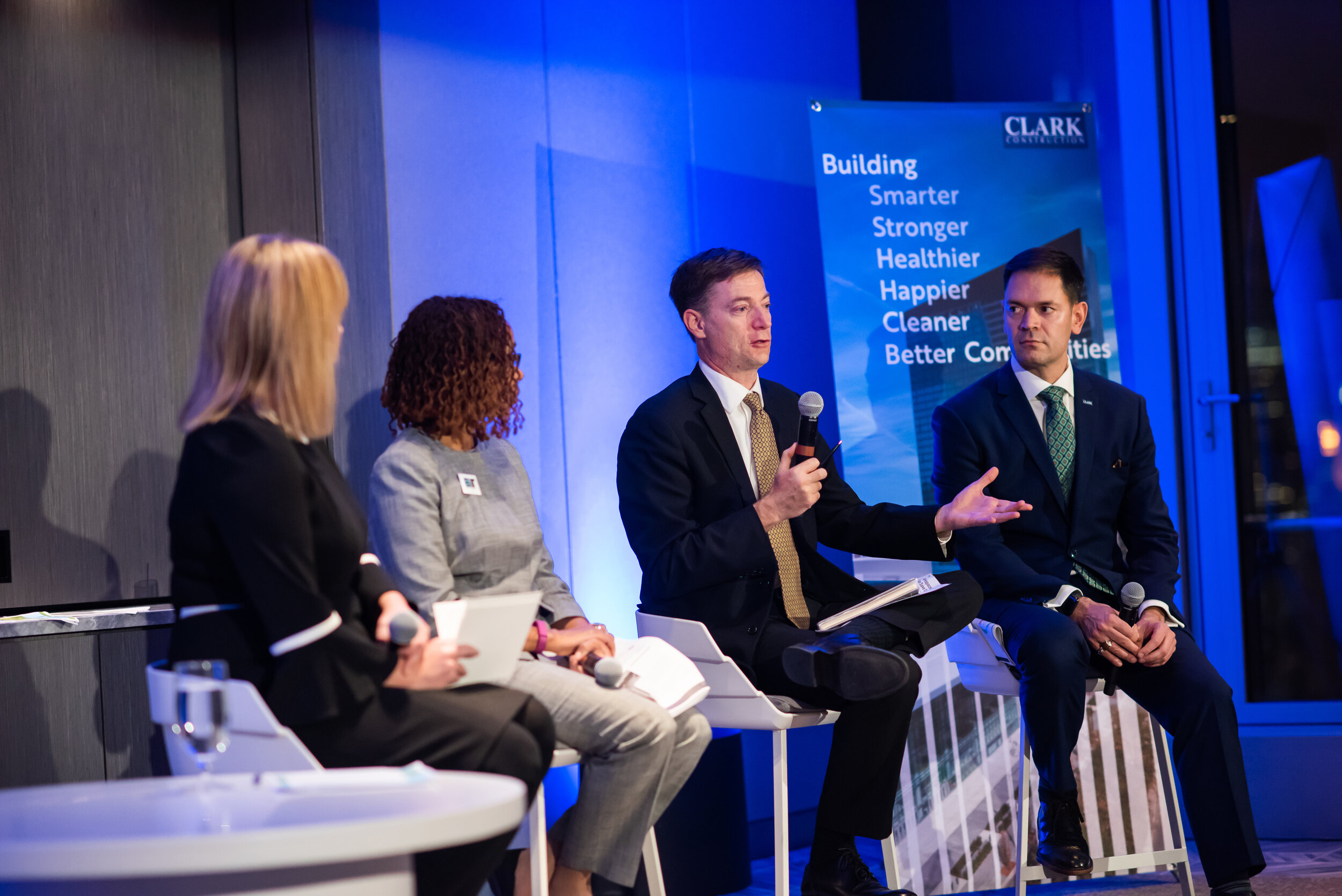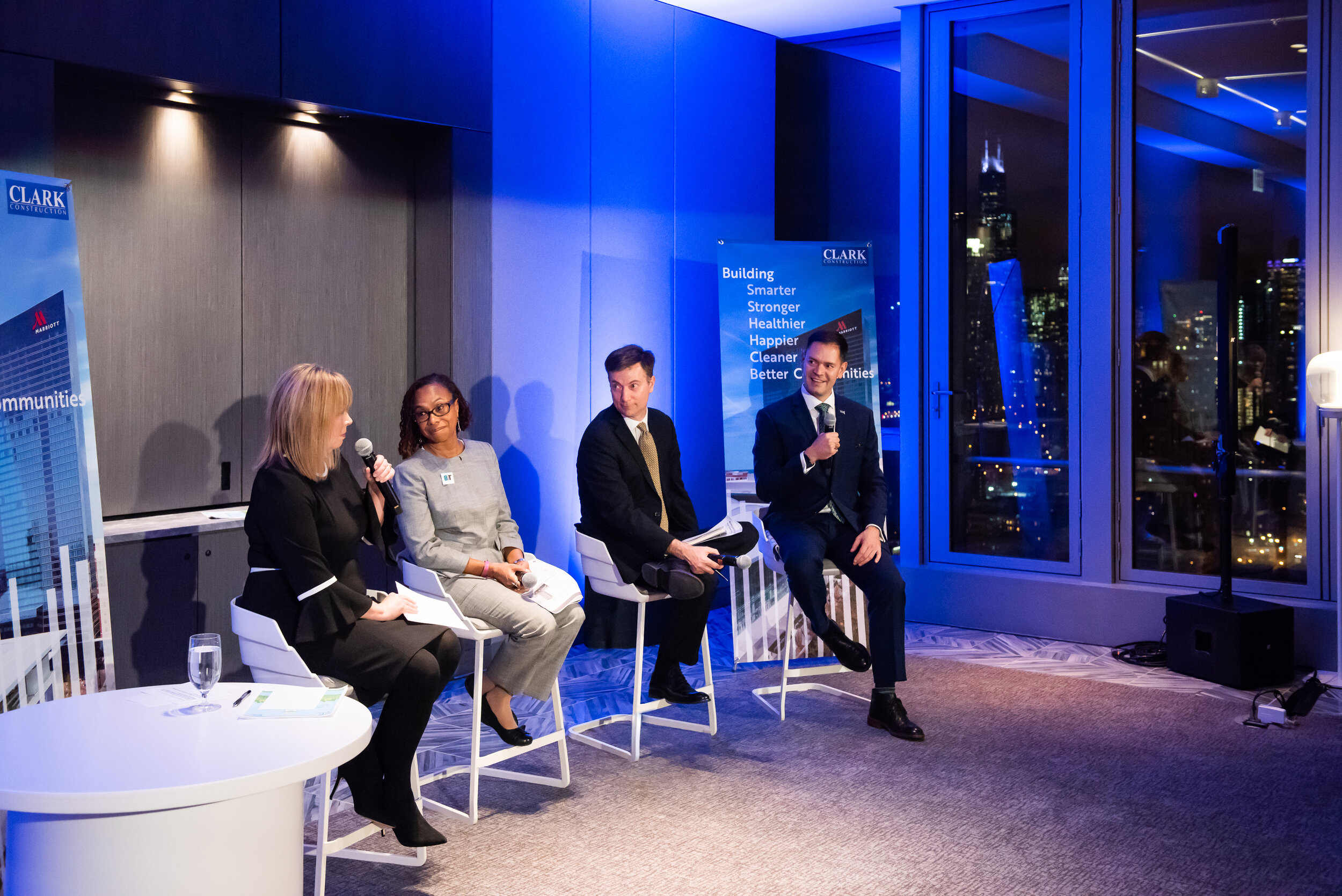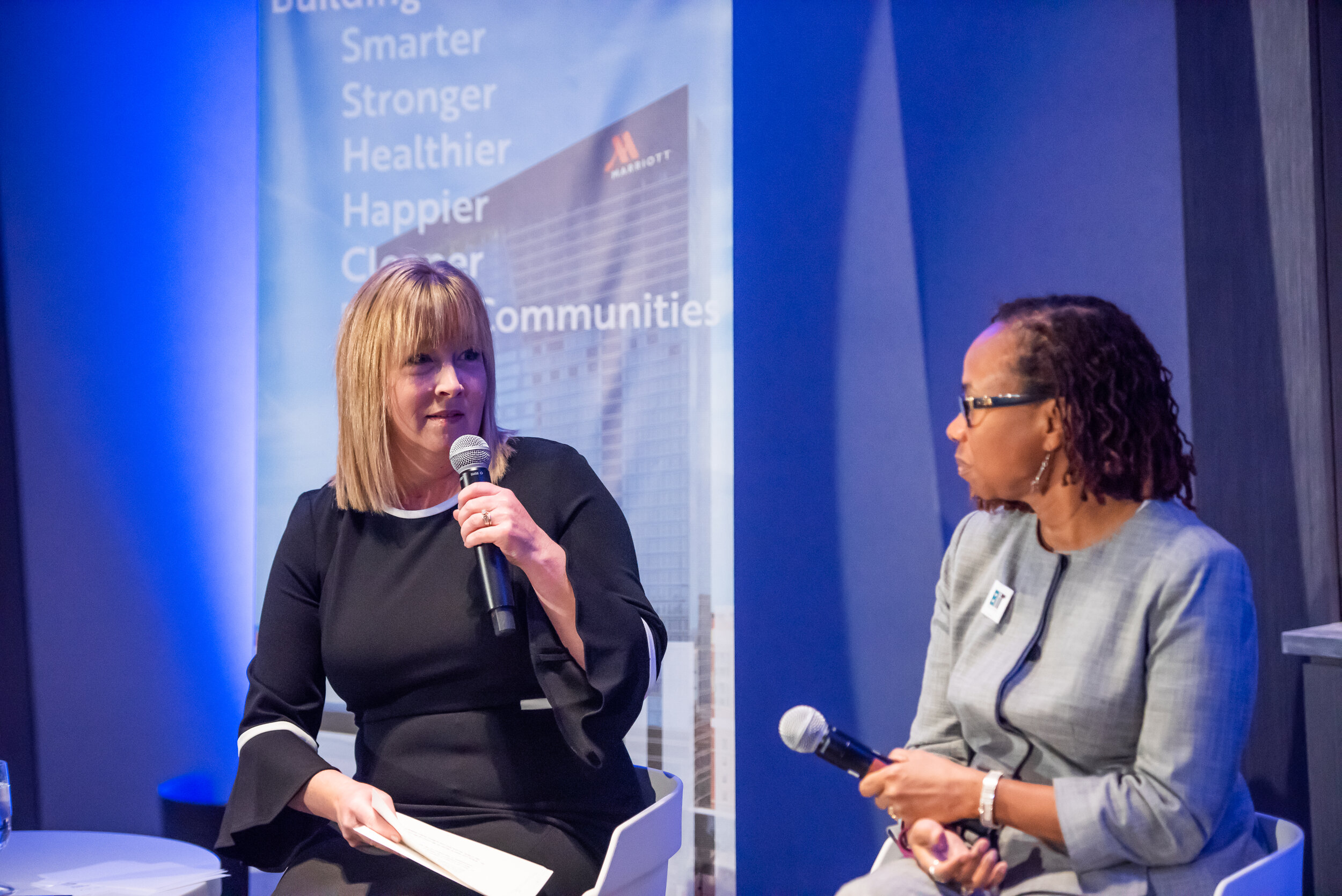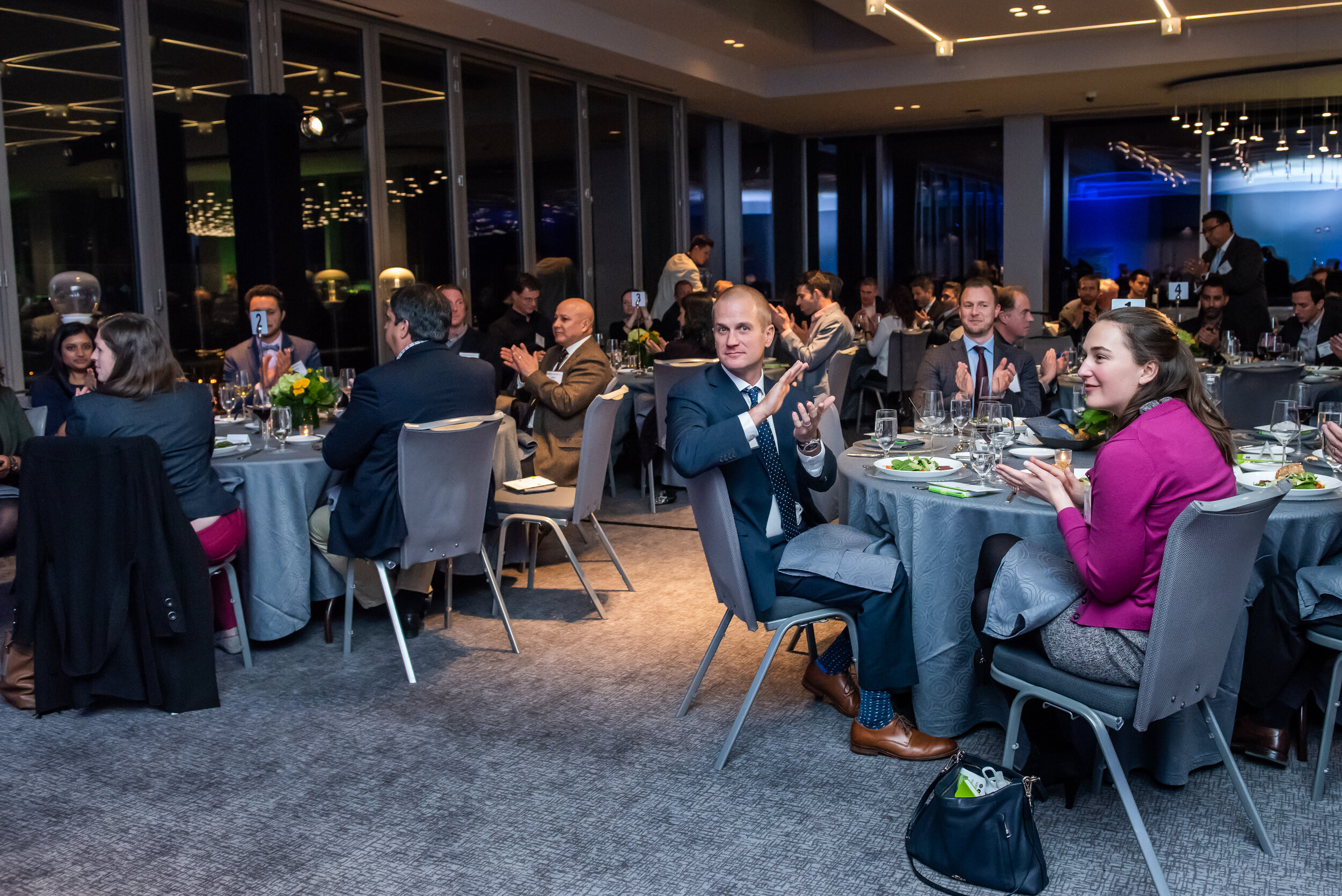5 Key Takeaways from Clark’s Industry Event on Making the Case for Green and Healthy Buildings
/As Greenbuild 2018 kicked off on November 14, Clark Construction hosted a stimulating cross-sector networking event for more than 50 industry leaders that featured a discussion with experts representing corporate, government, non-profit, and small business perspectives about “Making the Case for Green and Healthy Buildings” at the Marriott Marquis Chicago.
GreenStructure Owner Joanne Rodriguez moderated a panel comprised of:
Fernando Arias, Director of Sustainability, Clark Construction
Sandra Henry, Chief Sustainability Officer, City of Chicago
Cliff Majersik, Executive Director, Institute for Market Transformation (IMT)
Below are a handful of the panelists’ collective perspectives about the business case for green and healthy buildings.
1. Health and wellness is gaining traction as a value driver for green buildings
“Building owners,” Fernando Arias says, “are looking ahead at the innovations in sustainability that can help them capture greater market share in the commercial and multi-family buildings space.” Industry reports from organizations like stok, show that over 80% of a healthy buildings’ value comes from its ability to help attract and retain talented workers, and enable them to thrive and work more productively. Green buildings need to achieve much more than just high energy performance, but also need to be environments where occupants can adapt to a variety of live and work patterns that are supported by high indoor environmental quality — and healthy buildings can deliver that.
2. Green and healthy buildings are the growing norm for design and construction standards
“When owners, government agencies, contractors, and funders work together to drive the development of high-performing buildings and improved workplace environment, the business case for green and healthy buildings becomes apparent,” says Joanne Rodriguez.
Owners are realizing the financial benefits of green and healthy buildings through the support of organizations like IMT and through studies that have shown building certifications like Fitwel and LEED result in lower operating costs, improved worker productivity, and increased market value.
Driven both by market demand and environmental regulations, forward thinking developers and contractors are working towards the next phase of green building: healthier buildings that improve employee wellness. Lastly, cities like Chicago continue to influence through energy benchmarking and supportive code developments mandating a high-performance building environment.
3. Building owners are increasingly looking to invest in healthy, cost-saving buildings
“Clark’s clients want to build the highest quality green and healthy buildings that have the greatest ROI,” says Fernando Arias. The ability for green and healthy buildings to incorporate flexibility in both design and performance can address the immediate O+M costs savings of today, as well as the contingency in both design and performance to adapt to changing occupant behavior and outdoor environmental conditions over time. “We recently became the world’s first general contractor to adopt Fitwel because we are committed to implementing the highest quality standards for our own corporate offices, and walk-the-talk to deliver healthy work environments for our employees nationwide.”
“As we partner with building owners to implement intelligent and high quality air, light and water systems, we continue to learn more about the costs and benefits of improving the capacity for synergies between mechanical systems to create health-saving buildings, as is the case in one of our largest projects under construction in San Francisco, the Golden State Warriors Arena,” adds Arias.
4. Growing interest in green and healthy buildings gives practitioners a pathway to envision how people interact with the environments they occupy
“The growing interest and support for green and healthy buildings drives the broader sustainability and livability discussion because it gives practitioners a pathway to envision how people interact with the environments they occupy,” says Sandra Henry.
For Henry, “being part of this wonderful panel conversation reinforced the importance of advocating for and enacting policies that ensure all of Chicago’s 2.5 million citizens are living and working in green and healthy buildings.” In order to demonstrate the application of these policies, the city announced a new Chicago Energy Rating system starting in 2019 for buildings larger than 50,000 square feet. Properties in compliance with benchmarking reporting will receive between one and four stars on a four-star rating system, based on their 1-100 ENERGY STAR score. Building owners will be required to post their rating in a prominent location, and to share the rating at time of listing the property for lease or sale.
5. The business case for healthy, high-performance buildings is stronger than ever
“High-performance buildings are proven to yield occupancy premiums, which on its own creates a strong case for building owners to make green investments,” says Cliff Majersik. Energy savings that are generated from investments in efficiency can also help to reduce operating expenses, lower risks, and increase net operating income (NOI), positively impacting a building's value. Operational savings on maintenance can also add value, as building owners stand to lower maintenance costs and improve tenant comfort and satisfaction by installing more durable components such as better HVAC systems. Additionally, when green leasing practices are adopted, both landlords and tenants are able to align the costs and benefits of these investments and foster a more collaborative relationship between the two parties—leading to greater building performance and collective action on energy efficiency and sustainability.
For today's leading tenants, the health, well-being, and productivity of their employees is a top concern, as JLL’s 3/30/300 rule of thumb shows the average order of magnitude between a company’s costs are $3 for utilities, $30 for rent, and $300 for payroll per square foot annually. With a focus on employees, IMT is seeing significant growth of and demand for certifications such as Fitwel and WELL. In addition, several leading firms are adding lease requirements that ensure good indoor air quality, use of non-toxic products, green cleaning programs, and the provision of other health & wellness-focused amenities. IMT expects to see this trend grow in 2019 and beyond.
Fernando’s post 5 Key Takeaways from Clark’s Industry Event on Making the Case for Green and Healthy Buildings was first written in abbreviated form for Clark Construction.
Photos from “Making the Case for Green and Healthy Buildings”:






















































